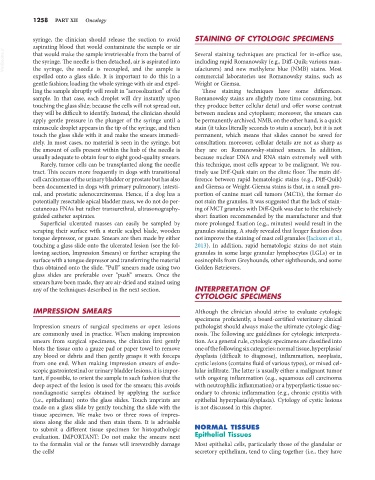Page 1286 - Small Animal Internal Medicine, 6th Edition
P. 1286
1258 PART XII Oncology
syringe, the clinician should release the suction to avoid STAINING OF CYTOLOGIC SPECIMENS
aspirating blood that would contaminate the sample or air
VetBooks.ir that would make the sample irretrievable from the barrel of Several staining techniques are practical for in-office use,
including rapid Romanowsky (e.g., Diff-Quik; various man-
the syringe. The needle is then detached, air is aspirated into
the syringe, the needle is recoupled, and the sample is
commercial laboratories use Romanowsky stains, such as
expelled onto a glass slide. It is important to do this in a ufacturers) and new methylene blue (NMB) stains. Most
gentle fashion; loading the whole syringe with air and expel- Wright or Giemsa.
ling the sample abruptly will result in “aerosolization” of the These staining techniques have some differences.
sample. In that case, each droplet will dry instantly upon Romanowsky stains are slightly more time consuming, but
touching the glass slide; because the cells will not spread out, they produce better cellular detail and offer worse contrast
they will be difficult to identify. Instead, the clinician should between nucleus and cytoplasm; moreover, the smears can
apply gentle pressure in the plunger of the syringe until a be permanently archived. NMB, on the other hand, is a quick
minuscule droplet appears in the tip of the syringe, and then stain (it takes literally seconds to stain a smear), but it is not
touch the glass slide with it and make the smears immedi- permanent, which means that slides cannot be saved for
ately. In most cases, no material is seen in the syringe, but consultation; moreover, cellular details are not as sharp as
the amount of cells present within the hub of the needle is they are on Romanowsky-stained smears. In addition,
usually adequate to obtain four to eight good-quality smears. because nuclear DNA and RNA stain extremely well with
Rarely, tumor cells can be transplanted along the needle this technique, most cells appear to be malignant. We rou-
tract. This occurs more frequently in dogs with transitional tinely use Diff-Quik stain on the clinic floor. The main dif-
cell carcinomas of the urinary bladder or prostate but has also ference between rapid hematologic stains (e.g., Diff-Quik)
been documented in dogs with primary pulmonary, intesti- and Giemsa or Wright-Giemsa stains is that, in a small pro-
nal, and prostatic adenocarcinomas. Hence, if a dog has a portion of canine mast cell tumors (MCTs), the former do
potentially resectable apical bladder mass, we do not do per- not stain the granules. It was suggested that the lack of stain-
cutaneous FNAs but rather transurethral, ultrasonography- ing of MCT granules with Diff-Quik was due to the relatively
guided catheter aspirates. short fixation recommended by the manufacturer and that
Superficial ulcerated masses can easily be sampled by more prolonged fixation (e.g., minutes) would result in the
scraping their surface with a sterile scalpel blade, wooden granules staining. A study revealed that longer fixation does
tongue depressor, or gauze. Smears are then made by either not improve the staining of mast cell granules (Jackson et al.,
touching a glass slide onto the ulcerated lesion (see the fol- 2013). In addition, rapid hematologic stains do not stain
lowing section, Impression Smears) or further scraping the granules in some large granular lymphocytes (LGLs) or in
surface with a tongue depressor and transferring the material eosinophils from Greyhounds, other sighthounds, and some
thus obtained onto the slide. “Pull” smears made using two Golden Retrievers.
glass slides are preferable over “push” smears. Once the
smears have been made, they are air-dried and stained using
any of the techniques described in the next section. INTERPRETATION OF
CYTOLOGIC SPECIMENS
IMPRESSION SMEARS Although the clinician should strive to evaluate cytologic
specimens proficiently, a board-certified veterinary clinical
Impression smears of surgical specimens or open lesions pathologist should always make the ultimate cytologic diag-
are commonly used in practice. When making impression nosis. The following are guidelines for cytologic interpreta-
smears from surgical specimens, the clinician first gently tion. As a general rule, cytologic specimens are classified into
blots the tissue onto a gauze pad or paper towel to remove one of the following six categories: normal tissue, hyperplasia/
any blood or debris and then gently grasps it with forceps dysplasia (difficult to diagnose), inflammation, neoplasia,
from one end. When making impression smears of endo- cystic lesions (contains fluid of various types), or mixed cel-
scopic gastrointestinal or urinary bladder lesions, it is impor- lular infiltrate. The latter is usually either a malignant tumor
tant, if possible, to orient the sample in such fashion that the with ongoing inflammation (e.g., squamous cell carcinoma
deep aspect of the lesion is used for the smears; this avoids with neutrophilic inflammation) or a hyperplastic tissue sec-
nondiagnostic samples obtained by applying the surface ondary to chronic inflammation (e.g., chronic cystitis with
(i.e., epithelium) onto the glass slides. Touch imprints are epithelial hyperplasia/dysplasia). Cytology of cystic lesions
made on a glass slide by gently touching the slide with the is not discussed in this chapter.
tissue specimen. We make two or three rows of impres-
sions along the slide and then stain them. It is advisable
to submit a different tissue specimen for histopathologic NORMAL TISSUES
evaluation. IMPORTANT: Do not make the smears next Epithelial Tissues
to the formalin vial or the fumes will irreversibly damage Most epithelial cells, particularly those of the glandular or
the cells! secretory epithelium, tend to cling together (i.e., they have

